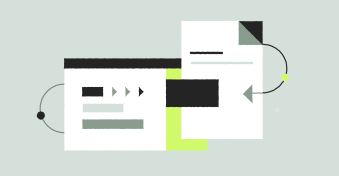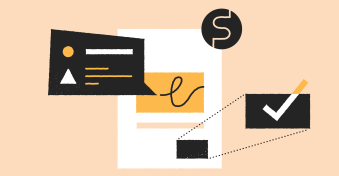Chances are that you’ve been working with multiple suppliers for a while but have only dealt with contracts so far.
One day, you get an email from a client mentioning something called “a PO.” What in the world is that?
Don’t panic — we’ve got your back! POs or purchase orders are a perfectly legitimate part of the business world — a very popular one for that matter — and PandaDoc is here to help you differentiate the distinctions between POs and contracts.
Let’s start with a closer look at what POs really are and how they are used by buyers and vendors to transact.
What is a purchase order?
According to Wikipedia, a purchase order is “a commercial document and first official offer issued by a buyer to a seller, indicating types, quantities, and agreed prices for products or services.”
The beauty of a purchase order is in its brevity and unambiguity, which enables virtually any employee within an organization to quickly generate one and submit it for approval to corresponding managers.
Purchase order and purchase requisition
In some organizations, internal rules of the purchasing department may require that the issue of a purchase order be preceded by a purchase order request or a purchase requisition.
A purchase requisition is an internal document describing the needs of a particular individual or department and containing a description of items to be purchased.
If you haven’t seen a purchase order before or need to refresh your memory on how they look — no problem! We’ve got a template for that.
One of the key characteristics of a purchase order is that it does not constitute a legally binding document right off the bat.
It only becomes one after the seller accepts the received PO and sends a signed copy to the buyer to confirm their readiness to fulfill the order.
Order, use, repeat
By the way, purchase orders don’t have to be a one-off thing.
If you need certain products on a regular basis, you can place a standing purchase order with a supplier to have your products delivered within a certain periodicity.
In this case, the supplier will be sending you invoices referencing the same purchase order number.
Another variation of a purchase order is a blanket purchase order.
Unlike other POs created for short-term needs, a blanket purchase order is typically used by government agencies to place multiple long-term orders for different items in exchange for volume discounts.
A good example of a purchase order is what Dwight Schrute would be collecting from his mail every morning after chatting with clients the day before.
These are orders for X reams of top-grade Dunder Mifflin paper and other office supplies to be delivered by a particular date to a particular address, hopefully with a few percent off the retail price.
Got the idea? Read on to find out how POs compare to contracts and what makes for a good PO.
What is a contract?
Contracts are a form of legal documentation that describes the most minute nuances of a business relationship between the contracting parties (of which there can be more than just two) and specifies the products to be supplied to the buyer or services to be rendered to the end client.
Contracts are traditionally used for purchasing services and complex goods that require additional shipping, handling, configuration, and warranty services, among other important things.
Contracts are typically a lot longer and much more detailed, addressing every aspect of the business between the parties and using a complex set of terms and definitions.
Finally, contracts are tailored for long-term engagements and usually come with renewal options so that they can be prolonged any number of times to ensure service continuity.
The many shades of contracts
Contracts come in all shapes and forms: short and extremely long, bilateral or involving multiple parties, serving different purposes, and placing emphasis on completely different aspects of the agreement.
One type of contract that you’ve probably already dealt with is a regular NDA or Non-Disclosure Agreement.
NDAs are signed between two or more parties that are about to enter a business relationship that implies the exchange of sensitive information.
NDAs regulate the rules of information disclosure to third parties, define the period of time covered by the agreement, and set forth the extent of accountability for breaching the terms of the document.
To use another example, software development contracts usually come in the form of framework agreements made up of Master Service Agreements (MSA) outlining the general, overarching terms of doing business between the parties and any number of Scope-of-Work (SOW) documents detailing specific tasks and projects to be completed for the client.
Let’s now consider some use cases where you’d have to choose between a full-fledged contract and a concise purchase order.
When should you use a contract and when will a PO do just fine?
Contrary to a common misconception, there is no strict definition of when a contract must be used instead of a purchase order and vice versa.
The rule of thumb here is to consider several important factors prior to making a decision.
Type of goods or services
The general approach here is “the more complex a product or service is, the more you should be leaning towards a contract or purchase agreement.”
Unless it’s a simple service with a fixed cost or a relatively inexpensive product, a contract will be a better option.
It is a better option for both the supplier and the buyer in terms of legal coverage, risk management, purchasing process clarity, and definitions of expected deliverables.
For example, a real estate deal or a software development project are almost guaranteed to be covered by a comprehensive contract made up of multiple parts and addenda.
However, if you are looking to purchase standard supplies or consumables once or on a regular basis from a local distributor, a PO will be the most obvious choice.
It will save you the trouble of running a contract by the legal team, waiting for edits to be accepted by the other party, and generally dealing with completely unnecessary layers of redundancy.
Expected duration
As a rule, long and complex engagements require a contract, while one-time or recurring purchases work well with purchase orders.
However, both contracts (purchase agreements) and purchase orders can be combined if the parties find it convenient and efficient.
For instance, a buyer and a seller can sign a general-type agreement and then use POs for every business transaction.
Even when it comes to services — like buying blocks of service hours from a software engineering company or paying a fixed monthly amount for a standard engineering role.
Risk exposure
The higher the cost of a product or service in question, the higher the inherent risks.
That is why companies working with high-value orders prefer to mitigate risks via contracts.
Low-cost purchases can be made with POs, and that is the preferred modus operandi for most businesses seeking to minimize the red tape and still keep accounting in check.
Here are some examples of situations where a simple PO just wouldn’t cut it:
- Outsourcing a business process to an outside vendor
- Buying a complex license for multiple users in your organization
- Forming a partnership
- Engaging in a business relationship that entails the disclosure of sensitive, confidential information
Structure of a typical PO
Based on what we already know about purchase orders, creating one shouldn’t be too much of a challenge, right?
That’s correct! Here are the staples of a typical PO that you shouldn’t forget about:
1. Header
Specify your company details, including name, registered business address, PO date, and PO number.
2. Vendor details
Make sure you get the name of the vendor’s organization right.
Include the company name, your sales contact, and the registered business address in this section.
3. Shipping details
Specify the shipping address, your preferred shipping method and terms, and the delivery date that you want your order to be delivered by.
4. Order details
Pay extra attention to this section.
List each of the items you are ordering on a separate line specifying corresponding product codes or SKU numbers, a short description, quantity, price per item, and the expected delivery date.
5. Totals and summary
Finalize the purchase order by providing a subtotal, any agreed-upon discounts, applicable taxes and fees, shipping costs, the preferred payment terms, and method, and, of course, the grand total.
Taking care of business
Purchase orders bring tons of benefits to the table for you as a buyer and for your vendors.
Reduced paperwork, order traceability, transparent accounting, ease of financial audits, speed of order processing, and lower efforts in the purchasing department are just a few of them.
If you are just setting up your business and looking for the best way to implement e-procurement practices, don’t hesitate to use our free PO template which has all the bells and whistles you’ll need for your own standard document.
By the way, don’t forget that PandaDoc has hundreds of handy templates in its growing collection and you are more than welcome to start using them to create better documents for your employees, clients, and partners!
Disclaimer
PandDoc is not a law firm, or a substitute for an attorney or law firm. This page is not intended to and does not provide legal advice. Should you have legal questions on the validity of e-signatures or digital signatures and the enforceability thereof, please consult with an attorney or law firm. Use of PandaDocs services are governed by our Terms of Use and Privacy Policy.


